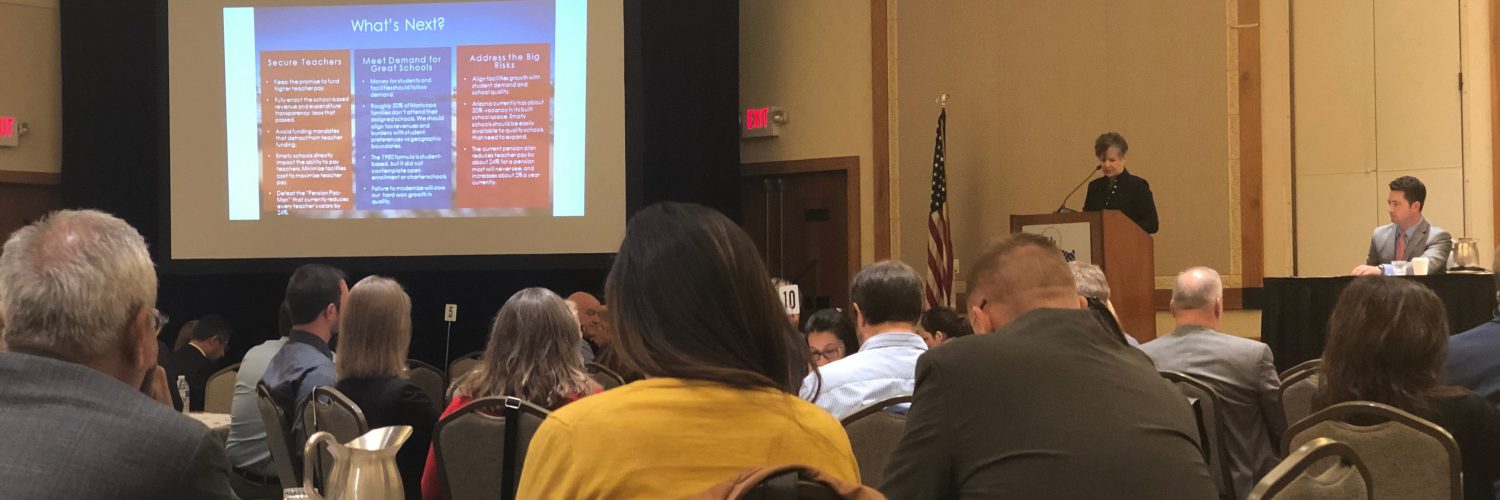Arizona’s education finance system needs modernization, but how do we do it?
Lisa Graham Keegan, Arizona Chamber Foundation Chief Executive and Sean McCarthy, Senior Research Analyst at the Arizona Tax Research Association (ATRA) shared their ideas with state policy makers about what it will take to push the state into the 21st century of school funding during ATRA’s Outlook Conference & 78th annual meeting.
“I grow really tired of the conversation that says this is so complicated,” Lisa Graham Keegan, Chief Executive, Arizona Chamber Foundation said. “We absolutely can deal with it, it ain’t that complicated.”
According to McCarthy, the problem lies in the fact that there are two funding models: charters get different monies than districts, creating an issue of fairness.
“Students [are] essentially worth different amounts depending on which school they show up at… kids [need to] be worth the same no matter which district or charter they show up at,” he said.
McCarthy believes that until the equity issue is addressed businesses shouldn’t sign off on new taxes. He said that more money into the existing system does not “buy equity,” it just throws revenue into an inequitable system.
Keegan said that the next step is securing teachers and meeting the demand for great schools.

Earlier this year, Arizona Governor Doug Ducey announced a 20×2020 plan to increase teacher pay 20 percent by 2020. This is projected to rocket the state from 40th in teacher pay to 16th.
“We were $10 thousand under competitive states. This was horrible for us, we were losing a lot of teachers to this,” Keegan said. “The cities in Arizona closest to the border, they have teachers going across. After this we’re going to be within probably a $1,500 difference.”
One of the things currently taking away from teacher pay is the amount of schools that are practically vacant.
“As long as we agree to allow an overhang of empty school space, schools that might be functioning with 25 percent capacity, that’s just a drain and that is operational funds. We have to make those schools available to other schools that will fill them or sell them. We cannot be sitting with these schools on everybody’s books like this,” Keegan said.
To meet the demand for great schools, McCarthy and Keegan agree Arizona needs to adjust the 1980 formula, which was student based but did not account for major policy changes such as open enrollment or public charter schools.
“If half of families don’t even attend the school [which is what] we built this formula for, where is the nexus between taxation and expenditure? I’d submit to you that it’s not there anymore and that the simplest, best, way to think about this will be revenues that are paid into by all of us for all students,” she said.
Another way to increase the amount of funding that can go towards teachers is to avoid funding mandates.
“You can’t pass a law for a reading program and say, ‘everybody’s going to do it right!’ That’s not what happens. Great schools implement the way they think they need to, and you cannot mandate your way into excellence, you can allow it, or you can get in its way,” Keegan said.
Both agree it’s time to change Arizona’s formula for funding all public schools.
“[We can] make the formula something that will work to grow the best schools that you have in Arizona. We’ve never been in this position before, we shouldn’t squander the moment. We could easily modernize this formula to comport with what Arizonans over the past two decades have put in place,” Keegan said.
















Add comment